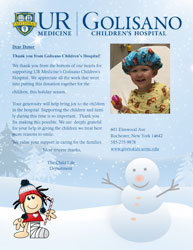News
The Department of Biochemistry and Biophysics hosts its 1st Annual Holiday Decorating Door Contest
Tuesday, December 22, 2020
The Department of Biochemistry and Biophysics recently held its 1st Annual Holiday Decorating Door contest. With only two labs participating in this year's contest, both labs were declared as winners. Congratulations to the Boutz Lab and the O'Connell lab!

O'Connell lab door
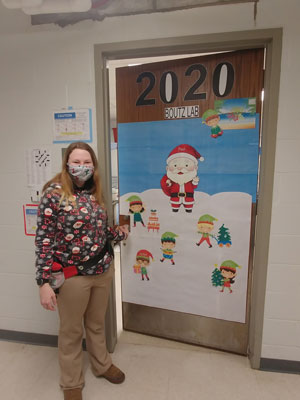
Boutz lab door
Department of Biochemistry and Biophysics Annual Toy Drive
Friday, December 18, 2020
The Department of Biochemistry and Biophysics held its annual toy drive this season to collect toys and items for the Golisano Children's Hospital. Dr. Alan Grossfield delivered a cart full of goodies to the Golisano Children's hospital on Tuesday, December 15th. The gifts are given to the children in the hospital during the holiday season. Any remaining gifts are used to support the needs of the children and playrooms throughout the year.

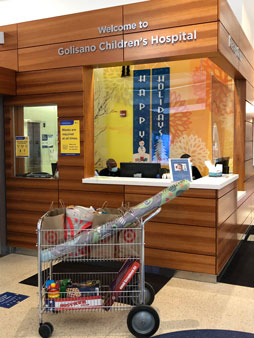
COVID-19 vaccine: What’s RNA research got to do with it?
Monday, December 14, 2020
The US Food and Drug Administration recently approved emergency use authorization for a COVID-19 vaccine developed by Pfizer and the German pharmaceutical company BioNTech.
The vaccine made history not only because it reported a 95 percent efficacy rate at preventing COVID-19 in clinical trials, but because it is the first vaccine ever approved by the FDA for human use that is based on RNA technology.
"The development of RNA vaccines is a great boon to the future of treating infectious diseases," says Lynne Maquat, the J. Lowell Orbison Distinguished Service Alumni Professor in biochemistry and biophysics, oncology, and pediatrics at Rochester and the director of Rochester's Center for RNA Biology.
COVID-19, short for "coronavirus disease 2019," is caused by the novel coronavirus SARS-CoV-2. Like many other viruses, SARS-CoV-2 is an RNA virus. This means that, unlike in humans and other mammals, the genetic material for SARS-CoV-2 is encoded in ribonucleic acid (RNA). The viral RNA is sneaky: its features cause the protein synthesis machinery in humans to mistake it for RNA produced by our own DNA.
For that reason, several of the leading COVID-19 vaccines and treatments are based on RNA technology.
A contingent of researchers at the University of Rochester study the RNA of viruses to better understand how RNAs work and how they are involved in diseases. This RNA research provides an important foundation for developing vaccines and other drugs and therapeutics to disrupt the virus and stop infections.
"Understanding RNA structure and function helps us understand how to throw a therapeutic wrench into what the COVID-19 RNA does—make new virus that can infect more of our cells and also the cells of other human beings," Maquat says.
In the past few decades, as scientists came to realize that genetic material is largely regulated by the RNA it encodes, that most of our DNA produces RNA, and that RNA is not only a target but also a tool for disease therapies, "the RNA research world has exploded," Maquat says. "The University of Rochester understood this."
In 2007, Maquat founded The Center for RNA Biology as a means of conducting interdisciplinary research in the function, structure, and processing of RNAs. The Center involves researchers from both the River Campus and the Medical Center, combining expertise in biology, chemistry, engineering, neurology, and pharmacology.
Daniel Steiner Wins The Sayeeda Zain Fall 2020 Travel Award
Friday, December 4, 2020

Congratulations to Dan Steiner for winning a Sayeeda Zain Fall travel award. Dan is planning to attend the SPIE Photonics West meeting, to be held at the Moscone Center, San Francisco, California, March 6-11, 2021, He states "I am excited to represent our department and present my work in San Francisco (virtually or otherwise) . Networking and reaching out to labs and PIs at this conference will help me learn more about the entrepreneurial side of science and how to develop my career after I defend." The Sayeeda Zain Travel Award honors the distinguished career and charitable life of Dr. Sayeeda Zain. The award is given in recognition of research excellence to support expenses associated with attendance at a scientific conference or corporate internship to gain practical experience. Dan Steiner is a Biophysics graduate student studying in Dr. Ben Miller's lab
Special Department of Microbiology and Immunology Seminar – Dr. Malika Grayson – November 9th at NOON
Friday, October 23, 2020
How do you make an impact when you are the only person in the room that looks like you? We hear the terms diversity and inclusion but forget that the term representation should be a reflection of diversity and inclusion combined. This isn't always the case. Dr. Grayson discusses her views on what it means to increase diversity and representation as an Individual Contributor. Learn more about her journey as the 2nd Black Woman to graduate with a PhD in Mechanical Engineering from her graduate institution. Hear about her current work as both an engineer, a STEM Advocate, and her most recent success as author of 'HOODED: A Black Girl's Guide to the PhD' where she highlights her time and lessons learned during her PhD Program.
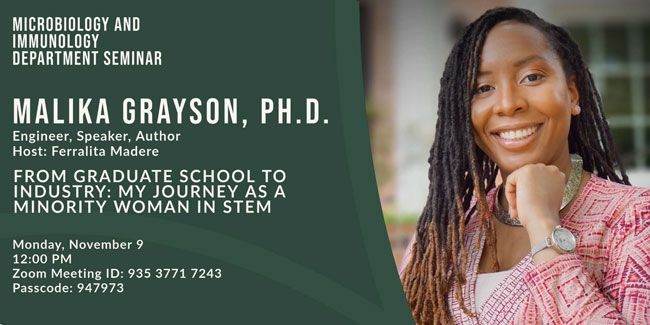
Nazish Jeffery, Biochemistry Ph.D. Candidate Pens Guest Column in the Democrat & Chronicle on Scientists’ Need to Communicate Clearly to the Public
Monday, October 19, 2020

Nazish Jeffery
Graduate student Nazish Jeffery published an editorial-style column entitled "Scientists Must Communicate More Clearly" which appeared on the Opinion page of the Sunday, October 4th edition of the Democrat and Chronicle. Ms. Jeffery argues that scientist have a civic duty to clearly inform and educate the public and public officials with regard to the results of biomedical research. She states "As scientists, our civic duty becomes twofold. Not only must we better our understanding of the world through research, we also need to use our training and expertise to help inform who govern so they can craft policies that are scientifically sound." Ms. Jeffery will be taking a brief hiatus from her laboratory research in Michael Bulger's lab to remotely participate in an internship with the American Institute of Biological Sciences in Washington DC, where she will focus on science and public policy.
Cool Technology Allows for Better Views of Cancerous Blood Cells in Quest for New Treatment
Tuesday, September 15, 2020

Clara Kielkopf, Ph.D., left, and Laura Calvi, M.D., stand by the University's new cryo-microscope
With the recent acquisition of Nobel Prize-winning technology and two new grants, Wilmot Cancer Institute researchers are streamlining their investigations into a malignant blood disease known as MDS, working toward discovering targeted therapies.
Laura Calvi, M.D., and Clara Kielkopf, Ph.D., are leading collaborative teams that will be using a device at the University of Rochester Medical Center — a cryo-electron microscope — that has ushered in a new era in biochemistry. The microscope allows scientists to see 3D snapshots and more details of living molecules than ever before, down to near-atomic resolution, to understand disease and uncover new ways to design drugs. The developers of the technology were awarded the Nobel Prize in Chemistry 2017.
Calvi and Kielkopf each received Edward P. Evans Foundation awards totaling $1.2 million for this project. Evans grants go to scientists seeking a cure for myelodysplastic syndromes (MDS), which originates in the bone marrow and disrupts healthy blood cell formation. MDS often leads to leukemia.
The Kielkopf lab will use the cryo-electron microscope to obtain 3D views of recurrent MDS mutations as guides for targeting molecular therapies. The modern microscope is the first of its kind in the Rochester region, Kielkopf said, and will be accessible to all UR researchers through the Electron Microscopy Shared Resource Laboratory. She is a professor of Biochemistry and Biophysics in the Center for RNA Biology.
David Mathews, MD, PhD installed as first Lynne Maquat Distinguished Professor in RNA Biology
Tuesday, September 15, 2020
We are thrilled to announce that Professor David Mathews, MD, PhD, was honored at this year's School of Medicine Opening Convocation by being installed as the first Lynne Maquat Distinguished Professor in RNA Biology in the School of Medicine and Dentistry. The professorship was awarded by Dr. Mark Taubman, Dean of the School of Medicine and CEO of the University of Rochester Medical Center. The Convocation was held virtually this year and can be viewed at the link below.
Congratulations to Professor Mathews!
GDSC Predoc Adrián Moisés Molina Vargas Passes his Qualifying Exam!
Thursday, September 3, 2020
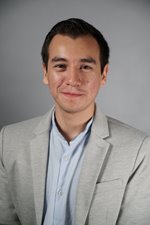
Adrian Vargas, a pre-doctoral student in the laboratory of Dr. Mitch O'Connell successfully defended his Qualifying Exam proposal entitled "Understanding guide-RNA design rules for efficient and specific Cas13 RNA-binding in human cells". Working on the recently described Type VI CRISPR-Cas system Adrian is investigating unique properties of the effector nuclease Cas13. His work has designed new approaches that will shed light on the mechanisms that govern optimal Cas13 RNA-binding, and potentially enhance its usability in human cells. Pursuing such goals not only will help complete our understanding of the gRNA requirements for on-target efficiency but more importantly, it will assist in uncovering what gRNA features contribute to off-target effects that could hinder the use of Cas13 as a specific RNA-targeting tool. The results will develop a more holistic biophysical model of Cas13 binding and cleavage activity. Congratulations Adrian on a job well done! You can read Adrian's thesis abstract below.
Title: Understanding guide-RNA design rules for efficient and specific Cas13 RNA-binding in human cells.
Abstract: Prokaryotic adaptive immune systems utilize Clustered Regularly Interspaced Short Palindromic Repeats (CRISPRs) and CRISPR Associated (Cas) proteins to target and cleave foreign genetic elements in an RNA-guided manner. The recently described Type VI CRISPR-Cas system contains a single effector ribonuclease, Cas13, that binds and processes a guide-RNA (gRNA), forming an RNA-guided RNA-targeting protein complex. Cas13 has been successfully engineered for potent RNA-knockdown in eukaryotic cells with minimal off-target effects, and other exciting applications described to date include utilizing a nuclease-dead Cas13 (dCas13) as a programmable RNA-binding protein for RNA imaging, RNA-splicing, RNA-detection or RNA-editing applications, among others.
However, the principles of guide-RNA selection for efficient and specific Cas13:gRNA RNA binding remain elusive. Previous work indicates that gRNA choice is important because not all gRNAs yield a robust RNA-targeting, and it is likely that there are different gRNA requirements for RNA-binding compared to RNA-cleavage applications. Furthermore, no predictive models exist for guide-RNA binding efficiency and specificity for Cas13 because no systematic screens have been carried out. Given that no transcriptome-wide measurements of Cas13-binding specificity have been attempted so far, it is unknown what the Cas13 off-target landscape is for human cells. Addressing this knowledge gap and quantitatively understanding the differences between binding and cleavage specificities is integral to the development of specific Cas13 RNA-binding applications.
In this project, I propose a series of approaches that will shed light on the mechanisms that govern optimal Cas13 RNA-binding, and potentially enhance its usability in human cells. Pursuing such goals not only will help complete our understanding of the gRNA requirements for on-target efficiency but more importantly, it will assist us in uncovering what gRNA features contribute to off-target effects that could hinder the use of Cas13 as a specific RNA-targeting tool, particularly for RNA-binding applications. In addition, these findings will be complemented by kinetic studies to dissect the biochemical components underlying Cas13 binding specificity to develop a more holistic biophysical model of Cas13 binding and cleavage activity. Consequently, we will generate a predictive model for Cas13 guide-RNA targeting specificity which will be complied into a comprehensive gRNA design tool tailored to different RNA-targeting applications for any RNA of choice. Finally, using the knowledge we generate and existing structural information, we will attempt to rationally engineer Cas13 and gRNA structure to enhance binding (and cleavage) specificities. Taken together, this work will bolster efforts to develop a range of RNA-targeting tools that can be readily used as research tools to address knowledge gaps in RNA biology, and as potential therapeutics.
RNA Essay Contest Results and Congratulations
Wednesday, August 26, 2020
The UR Center for RNA Biology offered an exercise during the time when COVID-19 became a sufficient threat to largely shut-down our research enterprise. We're pleased to announce the winners of the UR's Center for RNA Biology Essay Contest on "The role of RNA research in community health". These awards are sponsored by a grant from the RNA Society & Lexogen to the UR Center for RNA Biology, and funds from UR RNA Structure & Function Cluster.
Our Gold prize (~$1,000 value) award goes to Sydney Simpson, an Immunology, Microbiology & Virology graduate student in Steve Dewhurst's lab in the Department of Microbiology & Immunology, for her essay: "Nucleoside Analog Inhibitors: Timeless & Timely Beacons of Hope".
The Silver Prize (~$250 value) award goes to Omar Hedaya, a Biochemistry & Molecular Biology graduate student in Peng Yao's lab in the Department of Medicine/Department of Biochemistry & Biophysics, for his essay: "Know the Fundamentals when Seeking the Future".
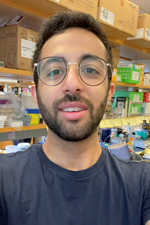
Omar Hedaya
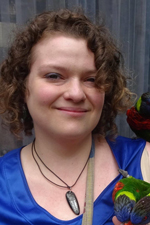
Sydney Simpson
Both awardees have become members of the RNA Society and will use their winnings toward technology needs for the upcoming semester.
The RNA Society now features our contest results, including the winning essays, in its latest RNA Salon update: https://www.rnasociety.org/featured-salons, see bullet #3.
We would like to acknowledge Honorable Mentions for the following applicants:
- Sai Shashank Chavali -- Graduate student; Biophysics, Structural & Computational Biology; Wedekind Lab
- Lily Cisco -- Graduate student; Cellular and Molecular Pharmacology & Physiology; Lueck Lab
- Gabrielle Kosoy -- Graduate student; Biophysics, Structural & Computational Biology; Miller Lab
- Ashwin Kumar -- Graduate student; Biophysics, Structural & Computational Biology; Topham Lab
- Li Xie -- Graduate student; Genetics, Development & Stem Cells; Pröschel Lab
We thank all who participated -- and our judges, too!
Kielkopf Lab Awarded EvansMDS Research Grant
Thursday, July 16, 2020

Prof. Clara Kielkopf has been awarded an EvansMDS research grant to use the new, state-of-the-art cryo-electron microscope at the U of R Medical Center EM facility. The Kielkopf group will use this revolutionary technique to study 3D structures of mutant U2AF1-splicing complexes in human malignancies. The title of the EvansMDS grant is: "Cryo-Electron Microscopy Structures of Mutant U2AF1-Containing Ribonucleoproteins Associated with Myelodysplastic Syndromes". This grant was made possible by our new Talos cryo-EM.

New article discusses biological implications of the intrinsic compactness of mRNAs
Monday, July 6, 2020
The Mathews and Ermolenko labs have recently showed that RNAs universally fold into secondary structures with short end-to-end distances. In this new article, possible roles of the inherent mRNA compactness in translation and mRNA decay are reviewed.
Cancer Investigators Pivot, Take on Coronavirus Research
Friday, June 12, 2020
While other cancer researchers had to temporarily close their labs in March due to the COVID-19 pandemic, Isaac Harris, Ph.D., and Josh Munger, Ph.D., shifted their focus to the contagion that has reshaped the world.
Using their specialized knowledge of viruses and genomics technology at the Wilmot Cancer Institute, the duo is searching for new and existing, U.S Food and Drug Administration-approved medications that could block the coronavirus.
They've tested 624 drugs on thousands of human lung cells infected with a strain of the coronavirus to see if the drugs have any impact. So far, they've discovered 15 potential compounds that appear to have anti-viral activity. Their criteria for a "hit" is for the drug to block 50 percent of virus-induced cell death. The team is validating the 15 drugs and trying to understand the mechanisms behind their potential anti-viral activity, Harris said.
This type of research is known as high-throughput drug screening -- a process that plays a big role in drug discovery in modern medicine. But instead of finding a new drug, here, investigators are looking to repurpose existing, available drugs for treatment of the coronavirus. This involves using automated, robotic equipment to match drug candidates with cellular events that occur during disease transformation. This form of drug-screening is often less expensive and faster than developing treatments from scratch.
Ermolenko lab uncovers a new mechanism causing ribosome pausing
Wednesday, June 10, 2020

Chen Bao
In a new paper just published in the journal eLife, the Ermolenko lab in collaboration with the Grigorieff lab at HHMI uncovers the underlying mechanism by which secondary structure in mRNA causes ribosome pausing. Specifically they show that mRNA stem-loops can cause translation pausing by inhibiting binding of tRNAs to the A site of the ribosome. The lead author on the work is Chen Bao, a Biochemistry graduate student. The work was funded by NIH.
Biophysics Students Win Hooker Fellowships
Tuesday, June 9, 2020
Congratulations to Chapin Cavender and Michael Bryan for winning University of Rochester's Hooker Fellowships, recognizing their achievements in their thesis research. Chapin and Michael are Biophysics students working in the labs of David Mathews and Ben Miller, respectively.

Michael Bryan

Chapin Cavender
This week’s URMC Research Heroes featured the Maquat lab’s Tatsuaki Kurosaki, PhD, and Shuhei Mitsutomi, MS
Wednesday, June 3, 2020
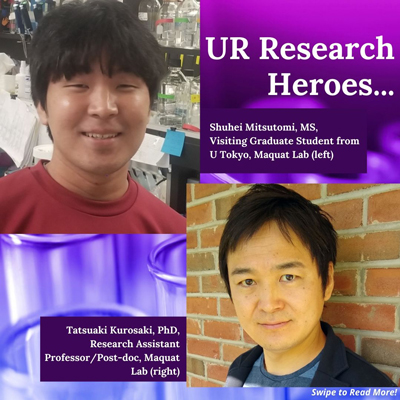
This week's URMC Research Heroes featured the Maquat lab's Tatsuaki Kurosaki, PhD, and Shuhei Mitsutomi, MS, who were recognized today for their work on SARS-CoV-2.
https://www.instagram.com/p/CA-QN7oAl07/
Both Tatsuaki and Shuhei have worked as members of the Maquat Lab (Center for RNA Biology and the Department of Biochemistry & Biophysics) during the sequestration on SARS-CoV-2, collaborating with a lab at Harvard to determine the mechanism by which the virus inhibits human-cell nonsense-mediated mRNA decay (NMD) so as to express and replicate its RNA efficiency.
From Tatsuaki: "Severe acute respiratory syndrome coronavirus 2 (SARS-CoV-2), which causes the coronavirus disease 19 (COVID-19) pandemic, is a novel enveloped RNA virus carrying a large (~30 kb) positive-sense single-stranded RNA genome. Although human cells innately have an RNA surveillance pathway called nonsense-mediated mRNA decay (NMD) that generally protects cells from infection by many different types of viruses, little is known about how SARS-CoV-2 inhibits NMD to proliferate in human cells. We hope that our research helps to elucidate the molecular mechanisms of SARS-CoV-2 proliferation in human cells, eventually contributing toward the development of therapeutic strategies to combat COVID-19."
University of Rochester RNA Essay Contest: “The role of RNA research in community health”
Wednesday, May 20, 2020

Sponsored by the RNA Society & Lexogen, UR RNA Structure & Function Cluster, and UR Center for RNA Biology
Who is eligible: Any University of Rochester graduate student or post-doc with an interest in RNA biology
Entry rules: Essays should be no more than two pages, single-spaced (excluding references, which should be present), 11-point Arial font, with half-inch margins all around.
Prizes: Two prizes will be given out. Gold (valued at ~$1000), and Silver (valued at ~$250). Additionally, winning essays along with photos of the winning authors will be posted on the Center for RNA Biology webpage and featured on the RNA Society's RNA Salon page, offering international exposure.
Details
The UR's Center for RNA Biology is running an essay contest, sponsored by the RNA Society & Lexogen, and UR's RNA Structure & Function Cluster, on "The role of RNA research in community health". This contest, which is open to all UR graduate students and post-docs, aims to promote creative yet data-driven thinking about the importance of RNA in the "big picture".
Considering that reliable technology is required for research in an increasingly virtual world, prizes will consist of a PC or Mac laptop for Gold winners (~$1000), and software licenses or peripherals (e.g., second monitor or laptop dock) for Silver winners (~$250), subject to the needs of each recipient.
Submissions must be emailed to Liz by Monday, July 13th, 2020.
Winners will be announced in the beginning of August.
Links
The RNA Society: https://www.rnasociety.org/
RNA Structure & Function Cluster: http://www.rochester.edu/ucis/rnastructure.html
Center for RNA Biology: https://www.urmc.rochester.edu/rna-biology.aspx
Chris Goodwin, Sierra Fox Celebrate 2020 Commencement at Home Along with 4,000 Students
Monday, May 18, 2020
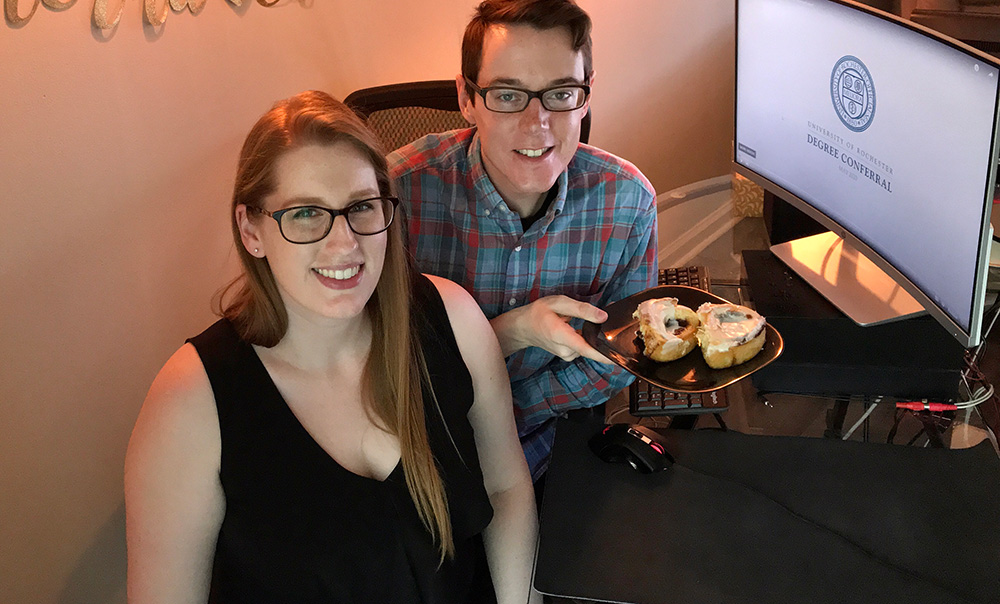
PALMYRA, NEW JERSEY: New biochemistry doctoral graduates Chris Goodwin and Sierra Fox celebrate at home.
Chris Goodwin and his wife, Sierra Fox, received their doctoral degrees in biochemistry from the School of Medicine. They met at the University years ago and both received master's degrees in 2016. They celebrate Friday at their home in Palmyra, New Jersey. "Going from grad school into quarantine has been very weird," Goodwin says.
They celebrated by baking cinnamon buns and eating them while they watched the online commencement videos and the School of Medicine and Dentistry biochemistry and biophysics department virtual award ceremony. "We had a 'Sierra and Chris' banner left over from our post-thesis defense party months ago and hung that up behind us for a more festive atmosphere," Goodwin says.
Biochemistry & Biophysics Hold First Virtual Awards Ceremony
Saturday, May 16, 2020
On Friday May 15th, the department held it's first virtual awards ceremony. Please see the video below:
Congratulations to all of our graduates:
Ph.D. Program in Biochemistry
Meemanage (Dudarshika) De Zoysa
Sierra Fox
Christopher Goodwin
Wan-Jung (Christine) Lai
Jiyu Wang
Hong Zhu
Ph.D. Program in Biophysics
Debapratim (Dave) Dutta
Letty Leslie Salas-Estrada
Congratulations to our 2020 award winners:
Walter S. Bloor Award
For excellence of the Ph.D. thesis and in the research leading to the dissertation in the Program in Biochemistry
Christopher Goodwin, Jiyu Wang
Marvel-Dare F. Nutting Award In recognition of an outstanding graduate receiving a Ph.D. in Biochemistry
Hong Zhu
George V. Metzger Award For excellence of the Ph.D. thesis and in the research leading to the dissertation in the Program in Biophysics
Leslie Salas-Estrada
Fred Sherman Award Program in Biochemistry award to a student who exemplifies the imagination, the excellence in the pursuit of scientific knowledge, and the commitment to the scientific community that were characteristic of Dr. Fred Sherman
Lisa Houston, Nazish Jeffery
William F. Neuman Award Program in Biophysics award for academic, scientific and personal qualities exemplifying the imagination, enthusiasm and excellence in the pursuit of scientific knowledge which were characteristic of the life of Dr. Neuman
Dan Steiner
William F. & Margaret W. Neuman Travel Award
Lauren Benoodt, Ashlin Poruthoor, Yoshita Srivastava
Elena Gilde Grossfield Biophysics Trainee Presentation Award
Talk -- Matt Brewer
Poster -- Gabrielle Kosoy
Dr. Hong Zhu Receives Marvel Dare Fellows Nutting Award
Friday, May 15, 2020
Dr. Mark Dumont, Advisor. Awarded by the Department of Biochemistry.
Marvel-Dare Fellows Nutting was the first woman to receive the Ph.D. in Biochemistry at the University of Rochester, June 1938. Her thesis, The Anti-Gonado Trophic Hormones in the Normal Blood Serum reflected the interests of Dr. Arthur Elden, Professor of Obstetrics and Gynecology and Dr. Willard Allen, Professor of Anatomy. Prior to beginning the Ph.D., she had worked with Professor Bloor, the first Chairman of Biochemistry and Dr. William McCann, Chair of the Department of Medicine. After time extending her thesis work, she took a position in Washington, DC as a Medical School faculty member, teaching biochemistry to students in the V-12 Program (an accelerated M.D. program designed to provide doctors for World War II)
In 1947, she began a career in the Department of Agriculture in California as an Associate Biochemist, with a focus on vitamins in vegetables, including frozen foods being developed at that time. A specific interest was Vitamin C in tomatoes and in this work she developed photometric and other technology for analysis. She headed a research group in food appraisal and statistics. An avid athlete she remained active in sports until her death in 2005.
She donated her hood from the 1938 graduation ceremony as her means of honoring women graduates in the Department of Biochemistry. In addition she has contributed funds to support the Nutting Student Travel Award as well as for the award associated with the Nutting Hood.
In 2004, at age 94 when the Nutting Hood Award was established, Dr. Nutting wrote:
"Words are inadequate to express my deep and sincere feeling of awe and humbleness in this matter. I can only ask you to extend my great thanks to everyone involved in this unexpected honor with its further extension into other years. I am convinced my thanks are in no way equal to these happenings. They are from the bottom of my heart".
Hong Zhu's thesis project focused on the identification of variant forms of the HIV envelope protein for use in HIV vaccine development. Dr. Zhu initially helped to establish a technology for displaying and detecting the envelope protein on the surface of yeast cells as a system allowing the protein to be subjected to in vitro evolution. Since poor binding of envelope protein to antibody precursors appears to be a major barrier to the elicitation of neutralizing responses to potential HIV vaccines, Dr. Zhu used large-scale random mutagenesis and extensive screening by flow cytometry to identify variant forms of the envelope that exhibit enhanced binding to precursor forms of broadly neutralizing anti-HIV antibodies. The variant forms of the envelope that she identified are likely to be trapped in conformational states that allow enhanced access for antibody binding. While performing this work, Dr. Zhu also completed coursework allowing her to receive a Master of Science Degree in Technical Entrepreneurship and Management jointly from the Simon Business School and the Hajim School of Engineering and Applied Sciences. While conducting her Ph.D. research, she also served as a consultant for Estée Lauder Inc.
Graduate Student Viktoriya Anokhina Elected Co-Chair of Gordon Research Seminar
Monday, May 11, 2020

Congratulations to Viktoriya Anokhina who was elected as a co-chair of the Gordon Research Seminar Nucleosides, Nucleotides and Oligonucleotides, to be held in 2021. The Gordon Research Seminar is a 2-day meeting that precedes a Gordon Research Conference. These seminars are organized by early-career scientists for trainees of all levels and junior scientists. Some of Viktoriya's responsibilities as a co-chair will include Keynote speaker selection and invitation, career panel participants invitations, fundraising, selection of speakers from submitted abstracts, and other organizational activities. To attend the 2019 meeting, Viktoriya was supported by the Sayeeda Zain and Graduate Women in Sciences travel awards.
Center for RNA Biology Contributes to Fighting Coronavirus
Tuesday, April 28, 2020
Viruses like the coronavirus that causes COVID-19 are able to unleash their fury because of a devious weapon: ribonucleic acid, also known as RNA.
A contingent of researchers at the University of Rochester study the RNA of viruses to better understand how RNAs work and how they are involved in diseases. As COVID-19 continues to spread around the globe, RNA research provides an important foundation for developing antiviral drugs, vaccines, and other therapeutics to disrupt the virus and stop infections.
"Understanding RNA structure and function helps us understand how to throw a therapeutic wrench into what the COVID-19 RNA does—make new virus that can infect more of our cells and also the cells of other human beings," says Lynne Maquat, professor of biochemistry and biophysics at the University of Rochester Medical Center and the director of Rochester's Center for RNA Biology.
In the past few decades, as scientists came to realize that genetic material is largely regulated by the RNA it encodes, that most of our DNA produces RNA, and that RNA is not only a target but also a tool for disease therapies, "the RNA research world has exploded," Maquat says. "The University of Rochester understood this."
In 2007, Maquat founded the Center for RNA Biology as a means of conducting interdisciplinary research in the function, structure, and processing of RNAs. The center involves researchers from both the River Campus and the Medical Center, combining expertise in biology, chemistry, engineering, neurology, and pharmacology.
While much of the research across the University has been put on pause, labs that are involved in coronavirus research remain active.
"Our strength as a university is our diversity of research expertise, combined with our highly collaborative nature," says Dragony Fu, an assistant professor of biology on the River Campus and a member of the Center for RNA Biology. "We are surrounded by outstanding researchers who enhance our understanding of RNA biology, and a medical center that provides a translational aspect where the knowledge gained from RNA biology can be applied for therapeutics."
Graduate Students from the Department of Biochemistry and Biophysics Featured in URMC Tribute to Learners
Tuesday, April 14, 2020
Biochemistry and Biophysics grad students and post docs Jessica Ciela (Munger Lab), Dan Steiner (Miller Lab), Joe Bucukovski (Miller Lab), and Morgan Monaghan, PhD (Munger Lab) were all featured in the Grad student appreciation week article this month. Congrats to them and keep up the amazing research!
ROC biotech company says lab tests of former cancer drug confirm it stops COVID-19
Wednesday, March 11, 2020
A vaccine for COVID-19 is likely years away. Yet a drug tested in a lab three weeks ago has been found to stop the virus from spreading from cell to cell.
The stunning announcement comes from a Rochester biotech company called OyaGen, Inc. The company is seeking to fast-track the formula to treat people who become infected.
"A treatment right now is the priority," said Dr. Harold Smith of OyaGen. He added the drug already has FDA approval for another use.
The tests were conducted at the federal government's integrated research facility in Fort Detrick, Md. A drug called Oya 1 had already been proven in lab tests there to be effective against Ebola.
"If it worked for Ebola, is it absolutely unique to Ebola, or would it work on other viruses?" asked Dr. Smith - though he said an actual drug for human consumption was never pursued.
The coronavirus was still new and contained to Wuhan, China when a sample of the live virus was shipped to the government lab for testing with Oya 1. Test samples viewed under a microscope show a clear "before" and "after" that indicates properties that allowed the virus to grow and spread were neutralized.
"The drug was so effective that, even though we got through our dose-testing, we had literally sterilized the culture of the virus, so we knew this was a powerful thing," said Dr. Smith.
Under a different name, Oya-1 was first developed in the 1960s as a treatment for cancer. It was later shelved as ineffective, but not before it received approval from the Food and Drug Administration. Safe dosage levels were determined for men, women and children.
"Clinical trials have already been done on this compound and, if safety is a main issue, we feel safety has been addressed years ago," said Dr. Smith.
He said preliminary research indicates a single dose of the medicine stops the progression of COVID-19 for eight days and continues to work at half-strength for another four days.
The question is whether the drug will react to the virus the same way in the body as it has in the lab. When an approved drug is proposed for a new use, the FDA usually requires new clinical trials.
13WHAM News reached out to the FDA, but we have not yet received a response.
OyaGen says the live virus tests were conducted and validated by a third party - the U-S government, and argue that is also a reason the drug should be fast-tracked.
"You've got this compound that's absolutely lethal to the virus, and we know it has a margin of safety in people," said Dr. Smith. "What are we waiting for?"
Golisano Children's Hospital Thanks the Department for it's Toy Drive Donations
Tuesday, February 11, 2020
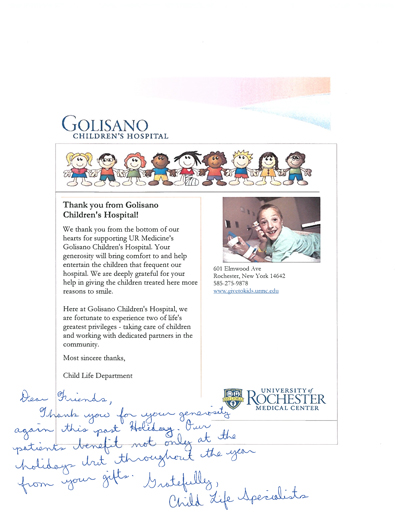

Professor Yi-Tao Yu is is quoted in Nature article, and a wins major grant award from the Cystic Fibrosis Foundation
Wednesday, February 5, 2020
Professor You was quoted in a Nature review article published February 4th, 2020, entitled Step Aside CRISPR, RNA Editing Is Taking Off. Dr. Yu stated that a large number of genetic diseases are the result of mutations leading to stop codons, resulting in a shortened protein that doesn't function normally in the body. He noted that the list of such diseases is very long and includes cystic fibrosis, the eye disease Hurler's syndrome, and numerous cancers. On February 6th, Dr. Yu was notified that he had won a major grand award from the Cystic Fibrosis Foundation entitled "CFTR nonsense suppression by targeted pseudouridylation." Congratulations to Dr. Yu!
